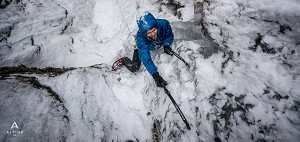
In this comparison review we have ice screws from the best in the business. From classic designs that have been around for a while through to new and ground breaking ice screws that will shave weight off your rack and bite in to the ice better than ever before. But which ice screws are the best? Which ice screws are the lightest? And which ice screws are right for you?
There are two main design differences on the market these days - ice screws with clip in points in the head/handle and ice screws that require a specialist quickdraw attachment that slides on to the screw itself. We have tested several of both designs in this review.
As a general rule we found that the original style of ice screw - with a handle/head a little bit like a bolt hanger - that you clip with a quickdraw, to be the most versatile in all climbing situations. You can choose which quickdraw you want to use depending on the placement, and you can rack the screws easily and neatly on plastic ice screw clippers that attach to your harness.
The screws with specialist quickdraws or ice hooks attached can be lighter (in that you don't need a full quickdraw as well as the screw), and as they can be unscrewed out of the ice whilst still clipped to the rope, could be very handy for guides/instructors taking inexperienced climbers up routes. However overall for our own climbing we preferred the original designs for most situations.
Each of the screws on test is described in detail below, and a summary table with star ratings is at the base of the article.
Black Diamond Express - Ice Screw £44.99 - 54.99
The Black Diamond Express ice screws have been around for a while and are well regarded amongst the climbing community. They come in 5 sizes and are colour coded on the handle: Red (10cm), Yellow (13cm), Blue (16cm), Grey (19cm) and Green 22cm). We had the middle 3 sizes on test and found them to be exactly the lengths stated and on the scales the 13cm weighed the stated weight of 134g, but the other two weighed 5 grams more than their stated weights at 149g (16cm) and 164g (19cm).
They are rated to 10Kn in strength.
The Express are a standard screw design in that they have a head that you clip a normal quickdraw in to. The head is a nice shape and size, fits well in the palm to 'get the screw going', and the flip out handle is a knurled metal and is great, quick and easy to use. The lower hole in the head accommodates carabiners easily and is similar to a bolt hanger in shape. There is also an additional clip in point on the head, which we found useful for clipping rucksack/ice axes/other faff to on belays/change overs.
The Express ice screws bit exceptionally well in to the ice, meaning that they were amongst the fastest and easiest to place in the whole test. Once they have bitten, they were also very easy to wind in, with the handle and shape working exceptionally well.
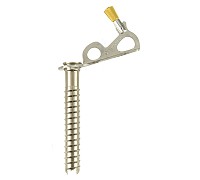
The heads racked quickly and neatly on ice screw clippers and were generally very easy to rack, un-rack as well as easy to place and remove from the ice.
Summary: A brilliant, well designed, well polished, easy to use, strong and simple ice screw that comes in a large range of sizes. Strongly recommended by the UKC test-team.
More info: Black Diamond Website
C.A.M.P. Radion - Ice Screw £55 - 60
The C.A.M.P. Radion ice screws come in 3 sizes: 12cm, 17cm and 22cm. We had the 22cm and the 12cm on test. They were their stated lengths exactly and weighed slightly more than their stated weights. The 12cm was 160g (5g over the 155g stated weight) and the 22cm was 208g (9g over the 199g stated weight).
They are colour coded on the winding handle as well as on the integral quickdraw sling attachment.
We couldn't find a stated strength rating on the website or on the screws.
The screws bit in to the ice reasonably well, and the large fixed size handle meant that they screwed in fairly easily, but not as easily as some of the other screws in the test.
Reverse Thread Angle: (more on this in the Grivel section below)
The threads on the screws were medium to large in depth but what we noticed was that they are angled on one side and straight on the other (like with almost all the other screws) but the straight side of the thread was actually the penetration side, and the angled side was the reverse side of the thread. Whilst C.A.M.P. have done this on purpose , stating "The Radion features a reverse angle on the threads (flat side towards the ice), to distribute pressure more uniformly in brittle ice" , without the technology to test this I am afraid we don't know if it is true, but thinking about it logically then having more surface contact from the angled thread walls means less pressure on the ice, which would be good on brittle ice as stated, but does the angle mean that the screws will pull easier - we just don't know. Does it even make any difference at all? We don't know, and couldn't discern any difference in use, and the screws held firm in good ice when we sat on them.
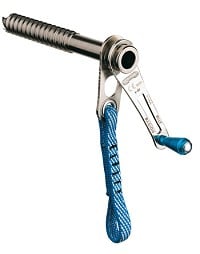
The handle and clip in point are two separate parts, both are not removable from the screw. The handle is quite long and does not fold away, but despite initial reservations we found that it didn't get in the way on the harness when the screws were racked in the method above, but was more of an issue in heavily featured ice especially when added to the fact that the (smaller but still quite long) clip in part of the head didn't have any outward movement/angle at all, so did occasionally get stuck on lumps of ice surrounding a placement. With some other screws that have a larger side surface on the head (such as the round shaped DMM screw) then you can whack the screw to turn it with your hand and force it over lumps and bumps, but this wasn't possible with the Radion..
One of the positive features of this design though was the fact that it can be clipped to the rope before it is wound in (or out), meaning that the screw won't be dropped. In use we found clipping screws to the rope before placing them to be impractical, but taking them out whilst they are still clipped to the rope (whilst you are seconding) did actually work a treat. So no dropped screws by your second anymore!
Summary: Decent screws with an interesting double unit on the head. Quite heavy for the size, but could be used just with a carabiner instead of a quickdraw, although we preferred not to. Awkward to clip. Interesting reverse thread design could increase holding power in brittle ice.
More info: CAMP Website
Climbing Technology Revolve - Ice Screw £85
The Revolve ice screws from Climbing Technology come in 15cm and 19cm and we had the 15cm on test. The stated weight of 84g seemed too good to be true, and on picking this screw up we knew it was incorrect. It came in at 167g on our scales (including the "ice hook" quickdraw) - basically double the stated weight. The length was accurate with the actual screw being 14cm in length and the head adding just over 1 more cm.
The distinctive looking screws are not coded for length, both sizes have the blue and yellow plastic head, with a fold out winding handle. They are rated to 10kn.
The screw bit well in to the ice, and the round shape of the plastic head was very comfortable and actually the easiest screw in the test to hold in your palm and 'get going' . The fold-away handle was quite easy to fold out with thin gloves and a little more tricky with fat gloves. When out it worked well and was a nice size. Due to the plastic look of the screw it earned the nickname "My first ice screw" but getting past appearances it actually worked pretty well.
The threads were a standard size and shape and worked as well as any on the test, with good holding strength and an easy action.
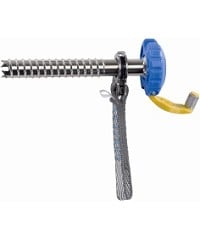
Summary: A truly novel design that does work and with no major flaws. They look funky, so will love it some won't. If you are a fan of the pre-attached quickdraw system then these are a cool alternative to other leading brands. If alpine mountaineering and versatility is your thing, then these are perhaps not for you. The RRP is quite high in comparison to other screws.
More info: Climbing Technology Website
DMM Revolution - Ice Screw £40 - 45
The simple and effective design of the DMM Revolution has been with us for quite some time. These ice screws are available in 10cm, 13cm, 17cm and 22cm. We had all the sizes on test. The weights of the screws were actually slightly lower than the stated weights (around 5g), and were: 104g (10cm), 124g (13cm), 141g (17cm) and 160g (22cm). In comparison to most of the other screws on test, the DMM screws are pretty light.
The heads of the ice screws are colour-coded to aid size identification.
The DMM Revolution screws are the only screws in this test that don't have a winding handle, and this does set them at a disadvantage in that respect, however the smooth rounded heads do have a little 'bump' and the technique for winding these screws in is to place your palm against this bump and rotate your hand - it does actually work surprisingly well if you can get your hand straight against the screw, and made the screws as easy to place as some of the other screws on test with handles. If the screw/ice/hand is at a funny angle, then it isn't quite so easy to do this method.
One feature of the DMM Revolution screws that we particularly liked was the glove friendly smoothness of the head (no torn gloves) and the ability to be able to thread a rope straight through the head if needed (imagine that the other ice screw heads are like bolt hangers, then these are like glue-in bolts - a rounded bar construction, not a thin squared edge).
The build quality was excellent, the thread were a medium size and gripped well. The bite of the screws was excellent. The large and rounded heads meant that 'whacking' the screws around whilst placing them when they were impeded by bits of ice was easy and didn't hurt.
The single clip in point on the heads was large and took a carabiner very easily, and also took a second carabiner if needed without any issue.
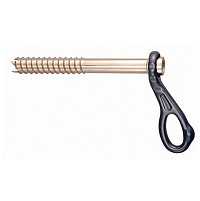
The screws racked neatly on ice screw clippers, and were easy to identify due to the large colour coding on the heads.
Summary: Simple, fairly light weight bomb-proof ice screws that have been around a while. No winding handle, but we thought the 'bump' method worked well enough. Good screws for the price - a thumbs up from us.
More info: DMM Website
Grivel 360 - Ice Screw £60 - 65
The Grivel 360 Ice Screws are available in 12cm, 16cm and 20cm lengths and we had all three lengths on test. They weighed 152g, 168g and 185g - which apart from the middle screw (they state 3.3oz - 93g - on the Grivel website, we think this is a typo) is almost exactly the stated weights. The screws are colour-coded on the winding handles for easy size recognition.
The head on the Grivel screws was a small, neat bolt-hanger type head, which did make placements in featured ice quite easy due to its small profile - it doesn't get stuck on lumps and bumps so easily, but it didn't rack perfectly on an ice screw clipper. It wasn't a major issue, especially if you only had Grivel screws, but mixing them up with other brands did cause a bit of twisting and wasn't the neatest rack. Couple this with the large folding handles (which work brilliantly for putting the screws in) and it did seem a bit of a faff on the harness.
Reverse Angle Thread: The Grivel 360s are (along with the CAMP Radions) a screw that features a reverse angle thread. We discussed this higher up in the review (in the CAMP section), but Grivel have produced a handy graphic on their website explaining it better than we can - here it is:
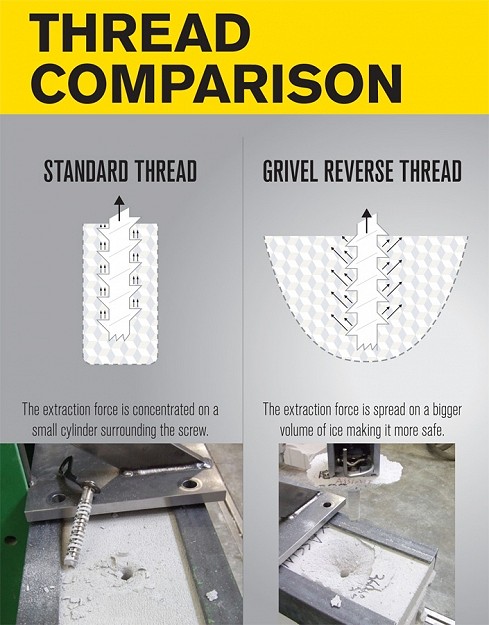
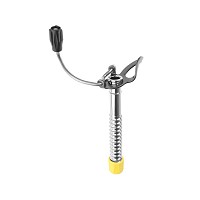
Back to the Grivel screws 'in use' and they bit extremely well in to the ice, they started off easily, with the head being easy to grab at any angle and the large fold out handle also working very well and giving a huge amount of leverage to turn the screws.
The large single clip-in point on the head accommodated two carabiners easily and worked well and the shape of it is designed so that you can clip the head when it is at any angle, not just pointing down, although we always turned the screw so that it was pointing down.
Summary: Really good screws with good bite, easy to wind in and a reverse thread. They didn't rack quite as neatly as some of the other screws, but not a huge issue. The winding handle was one of the longest on test and made for easy winding even in tough ice.
More info: Grivel Website
Petzl Laser Speed Light - Ice Screw £57.99 - 61.99
BEST IN TEST winner, the incredibly light and brilliant Laser Speed Light screws from Petzl were a joy to use. We couldn't find a Kn rating but they are CE and UIAA certified and come with a 3 year guarantee. They are available in 3 sizes: 13cm, 17cm and 22cm with stated weights of 91g, 100g and 110g. We weighed them and found that they actually weighed 2g less per screw than the stated weights.
This puts them as the lightest screws on test, by a huge margin. When you pick these up they feel light - it is instantly noticeable. But how have Petzl done this? They have made the tube of the screw in aluminium and only the teeth are steel. The steel tip sits inside the aluminium tube, and sticks out, meaning the tips are sharp steel, and you can sharpen them like any normal screw. The join between the two metals is very well done and although we have only used these screws for 1 season, they have absolutely no sign of coming loose - they are solid.
This lightweight aluminium tube is not as tough as regular steel tubes though and if you clear the screw by tapping it on rocks (we all do it!) then the threads do get damaged a lot easier that steel screws. However with a little care you can totally avoid this, just clear the ice from the inside of the screw by tapping the head. One other point about the threads was that they are the smallest of all the threads on test. What this means about grip power we are unable to tell.
Back to the head, it is very low profile, and easy to grab at any angle, meaning starting the screws off is a breeze and it also doesn't get impeded by featured ice. The head has a very neat fold-out winding handle that is colour-coded to ease size identification, and when it is folded out it is a good size and easy to use.
The tip is fantastic and bites in to the ice brilliantly, one of the best on test.
The screws are a basic shape overall and racked very neatly on our ice screw clippers.
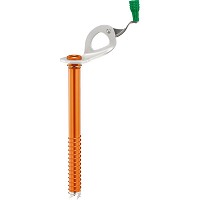
Summary: Great screws that are unbelievably light. They work exceptionally well, rack well, weigh next to nothing and - being bright orange - they even look cool. Downsides are that they can ding up easily on the threads and they cost about a tenner more than similar steel screws, but if that £10 is available, then the saving in weight is, we think, worth it.
More info: Petzl Website
Salewa Quick Screw - Ice Screw £69.99 - 79.99
The colour-coded Quick Screws from Salewa are available in Green (13cm), Blue (16cm) and Red (19cm). We had a single screw to test in 19cm. It weighed 228g (with integral quickdraw) and was more like 20cm in length. The stated weight of the 13cm version is 180g but we haven't tested that.
The Quick Screws come with an integral quickdraw (there is no clip-in point on the head) and a plastic housing system on the sling to keep the sharp end of the screw away from gloves, harnesses and pants etc whilst climbing. Before discussing this system, lets focus on the actual screw:
The screw performed quite favourably, with a good bite of the teeth, a smooth action in the ice and (when you have the head in your hand) a nice feeling and easy to use head and handle system.
We really liked the threads, they were some of the smoothest to use of the bunch, but also were well designed with a nice tapered front but also the largest flat rear edge of the whole test.
All good so far, but we didn't like the system part.
At 31 seconds in the video below we are shown the ice screw in use, but the video fails to show the removal of the screw from the harness and the motion required to set the screw up to enable a one handed placement, which is the trickiest part of this system.
The easiest way that we found to do this (and when we say easiest, it is still a pain) was to remove the screw from its plastic housing whilst the carabiner is still attached to the harness, then pivot the screw to bring the head up close to the carabiner, and hold the head with the palm, whist releasing the carabiner from the harness with a couple of fingers. If you remove the carabiner from the harness before opening the screw out of its holster, then it is a real faff to grab the head without dropping the whole unit. With normal ice screws you of course are already holding the head, as that is what you grab to unclip it from your ice screw clipper.

Another fault we found with the plastic housing system is where it sits when the screw is placed. It is directly under the screw and behind the quickdraw tape meaning that on anything less than vertical ice a fall would result in a significant amount of pressure being applied to the plastic housing, we found this out whilst hanging from a screw to rest our arms (all in the name of gear testing you understand!). Whilst not a safety issue, it does mean your 'screw system' might not last very long, and without the plastic bit you just have to rack the screws from their integral quickdraws, which we found very 'dangly' and can shred your pants easily.
The final thing we didn't like is that fact that the handle, which folds away very neatly and fits very well in the hand, actually hits the integral quickdraw if you try and fold it away when the screw is fully wound in. It is in fairness a minor complaint, as when in use the screw will usually have its handle opened, but it does show the screw in the video being used in tight spaces with the handle being tucked away nicely.
Summary: A good, well polished actual screw with good bite and a handle that is compact and easy to use once you have it in your hand. A major downside for us was the integral quickdraw and the plastic housing system which we found unwieldy, difficult to use and very limiting.
If you like the idea of the racking system and you want a set of screws just for icefall cragging and not for all purpose mountaineering, then these could be worth a look, but try before you buy as the system will certainly take a bit of getting used to.
More info - Salewa Website
Overall Summary
|
Model |
Price | Weight | Ease of Use / Racking | Bite / Winding | Overall Rating | Summary |
|
Black Diamond Express |
£44.99 - 54.99 | 149g (16cm) |
Brilliant, easy to use, bomb-proof screws that performed well in every way. |
|||
|
C.A.M.P. Radion |
£55 - 60 |
208g (22cm) (with QD) |
Good screws with a large handle that was easy to wind, but a little cumbersome. |
|||
|
Climbing Technology Revolve |
£85 |
167g (15cm) (With QD) |
A unique design that was easy in the hand when starting the screw off. Expensive. |
|||
|
DMM Revolution |
£40 - 45 | 141g (17cm) |
Great screws at a really good price. Simple and effective, but no winding handle. |
|||
|
Grivel 360 |
£60 - 65 | 168g (16cm) |
Excellent screws with a big winding handle. Not the easiest to rack, but great in the ice. |
|||
|
Petzl Laser Speed Light |
£57.99 - 61.99 | 100g (17cm) | |
Amazingly light and really well designed. These were absolutely brilliant in every way. |
||
|
Salewa Quick Screw |
£69.99 - 79.99 |
228g (19cm) (with QD and carabiner) |
A clunky system overall, but a good actual screw and screw head/handle. |

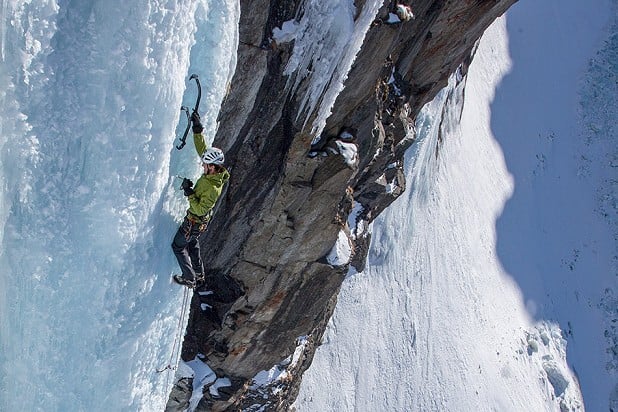



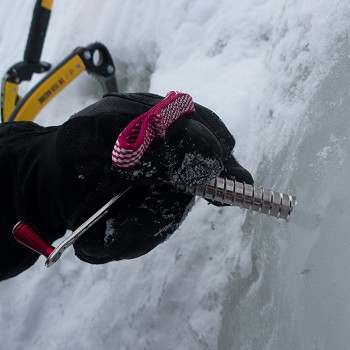
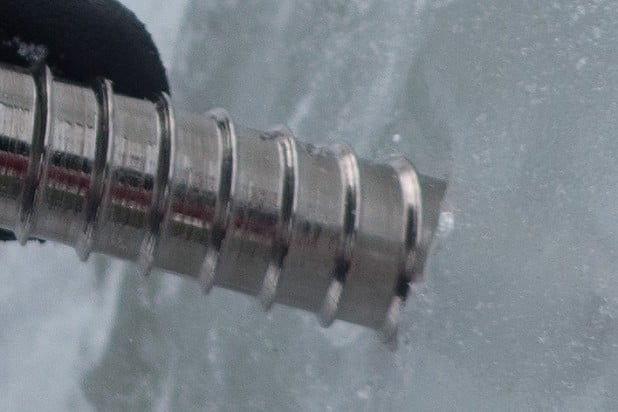
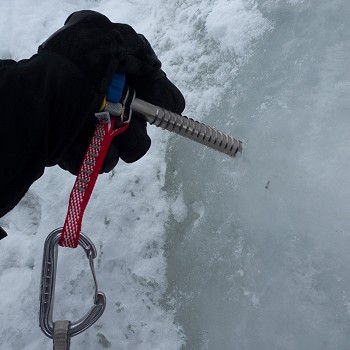

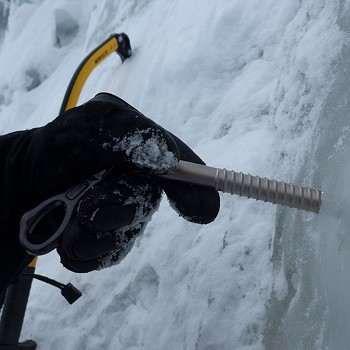
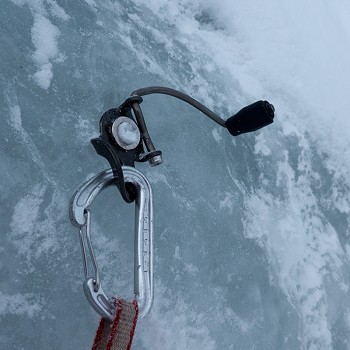
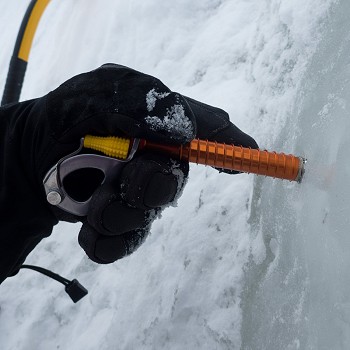

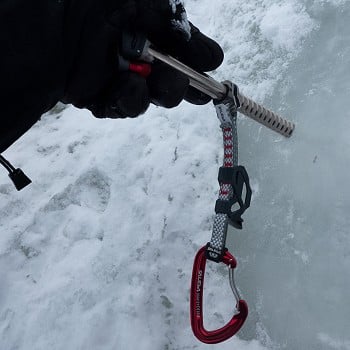








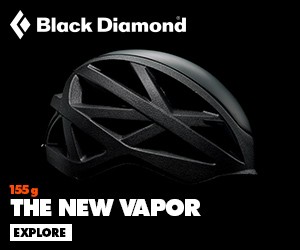

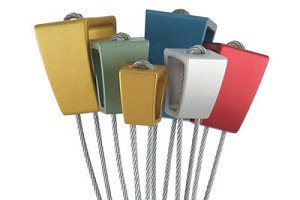
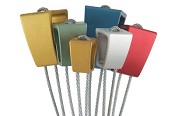
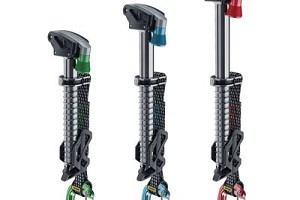
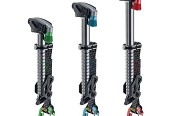
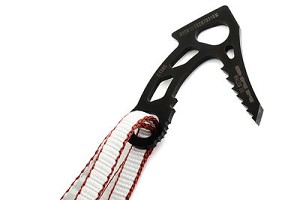
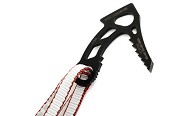
Comments